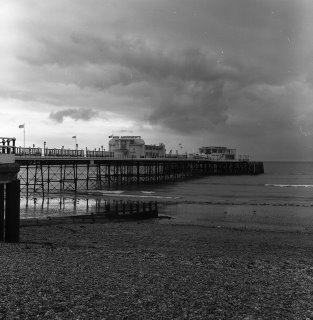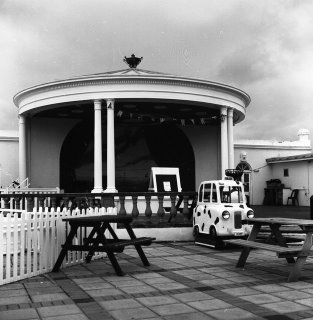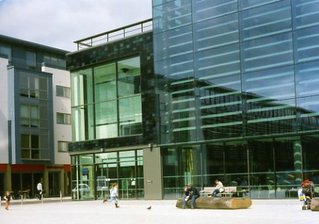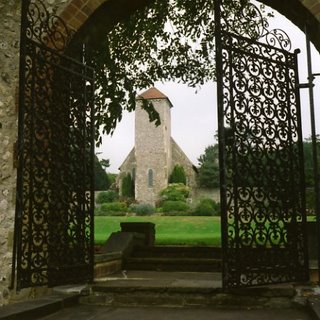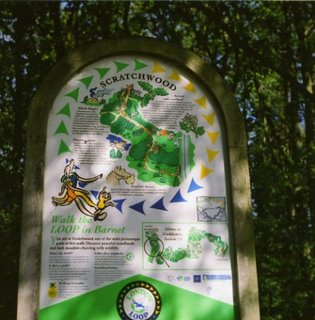An early start on Friday enabled me to complete this walk. The thing is, in this corner of Norf London it is supposed to be very posh and posh people in the early part of this century did not want the railways bringing day trippers to their lovely areas no thank you! So the railways didn’t come, apart from the Metropolitan Line (see Diamond Geezer for that) and there are very few trains in these oh so outer suburbs.
The walk started and finished on a golf course and even on Friday I was dodging the golf balls although at the Moor Park end there were only one or two golfers at nine o’clock on a Friday morning. One or two cutie pies walking dogs though who flashed me a nice smile and a “good morning”. I soon left the golf course behind and went into Sandy lodge lane with a view over the Colne Valley, and down to the main road, Hampermill Lane and up through some posts to a little playing field for the council estate beyond. I was glad to know that there were some ordinary people living near Moor Park station, even if they were not too near. I walked through the estate into Oxhey Woods, where I managed to get completely lost. There was a waymarker (the first I’d seen that day) but it was of little use. I found I was near the reservoir after a brief excursion down a very exclusive road, probably inhabited either by film stars or Russian ‘businessmen’ or maybe just successful solicitors/estate agents/prostitutes and the like. It was in Oxhey woods that I lost my digicam so there are no pictures of this spot until I get my films developed. If anyone finds it can they please hand it in to the police. When I lost my way I spoke to somebody who was walking around and asked where Pinnerwood Farm (my destination) was and he said that it was over two miles away. It seems like he was a person who only drives because the farm was a lot less than that, but it would be over two miles to drive. Anyway, I got back on the loop with minimal trouble and reached the rather scruffy stud that is Pinnerwood Farm. I took in some beautiful views of Harrow Church, on the hill, and the new Wembley stadium. This brought back memories of the Capital Ring and how much better that walk was signposted. I never got lost on the Capital Ring. What – never? No – never! What – never? Well – hardly ever. And I’ll come back to Gilbert and Sullivan later.
Pinnerwood House (adjacent to the farm) was where Edward Bulwer Lytton lived in the 1830s. He was a politician and a popular author, and actually invented part of the name BovrilTM from his book ‘Vril: the power of the coming race’. Bovril has been in the news today as UnileverTM are putting Beef extract back in the product having taken it out in response to concerns from Muslim countries (where Bovril is a top seller) that the beef was not slaughtered in a halal manner. They must now be sourcing halal beef. Going back a little way to see if I’d dropped my camera, I was accompanied by the farm dog, a Pyrenean mountain dog which is so called because of its resemblance to a mountain. It did not accompany me very far though and I crossed another few fields along the backs of ordinary bungalows. There were an amazing number of apples strewn along the backs of these suburban semis, which was weird. Some were just crab apples but some were of an eatable size. They couldn’t all have been rotten.
After this edge of suburbia with fields on one side and semis on the other I came to a lane that crossed the main railway line to Birmingham and the North West. The bridge was very narrow to accommodate the little country lane this road had been but was no longer and while I was standing there I heard a scrape of metal on brickwork. A bloke in a Bentley, yes a Bentley, had scraped his passenger side on the brick of the bridge!
The road led past a garden centre up through another golf course, with a surprising number of players, including a man out with his son. Golf courses tend to be quite badly waymarked but this one was OK.
I left and entered the ancient earthwork that the Ordnance Survey refers to as 'Grim’s Ditch' but others refer to as Grim’s Dyke. Grim is Wodin, the Norse God, and Grim’s Dyke is an earthwork. I doubt that the people who constructed the earthwork called it Grim’s Dyke. Try as I might I can’t get excited over earthworks. They may be just the iron age equivalent of landfill. Who knows why they built them and really who cares. They are practically invisible now, although I don’t know why that should be. One archaeologist advised me it was earthworm activity. He also advised me that low doors on ancient buildings were because the floors had been built up. I have no reason to doubt these explanations but for earthworks at least perhaps they weren’t very big to begin with.
I deviated from the route at Grim’s Dyke to photograph the house (now a hotel) where W.S. Gilbert lived (I did say I’d come back to Gilbert and Sullivan).
HREF='http://photos1.blogger.com/blogger/5802/1324/640/Grimm%27s%20Dyke570.jpg'>


This one would put the others I say to shame. If people today think they are rich living in a house on a street think how wealthy Gilbert must have been as a highly successful dramatist. Followers of Gilbert and Sullivan will note the use of the word ‘dramatist’, which is how Gilbert referred to himself absolutely detesting the word playwright which he used to describe Shakespeare, another pet hate (and mine too). Norman Shaw designed Grim’s Dyke in 1872 in the popular Tudor style. Gilbert moved in in 1890 after his success with possibly during the run of the Gondoliers. He changed the name from Graeme’s dyke. There is lots of ref brick, stone mullions and half timbered gables. The route sadly passed by the lake in the grounds where Gilbert drowned in 1911 while assisting a young girl visitor during a swimming lesson. The lake is just about dry now and there are some rotting remains of a summer house. There is a plaque on the lake to commemorate Gilbert and there is a blue plaque on the house itself.
Leaving the grounds past a British Telecom openreach transmitting station and former gravel workings on the Harrow Weald common, I came onto Bentley Priory circular walk. In a very deserted part of the common, I came upon a man sitting on a bench with a woman. Nothing odd about that except they never moved as I approached and the woman kept her face hidden. Perhaps she was somebody else’s wife.
This part of the walk takes a War Department concrete path. Passing by a bizarre collection of dumped walking frames, I could not see Bentley Priory, which is still an air force establishment with standard hutments and assorted military buildings. I followed the WhD concrete path outside the buildings (admiring the concrete boundary posts) and sitting on a seat while the clock at Bentley Priory struck one. Then time to move on into another unadopted road, with a 1930’s house all in white with a green roof, which rather appealed. In fact, this street was a bit of a millionaires’ row, it’s surprising the number of these I have encountered on my travels. But I must always take the rough with the smooth and I was soon walking through the pretty village of Stanmore with its hall with William Morris Interiors. Stanmore had a pretty village green and two ponds which legend has it were dug by the Romans. And maybe they were – who can tell after all this time.

Passing the ponds I came out by the Royal National Orthopaedic Hospital with its 1930s to 1950s buildings. I walked by a farm then under the M1 motorway at Junction 4. I went onto Elstree Road where drivers were driving far too fast. I don’t want to be a patient at the Royal National Orthopaedic Hospital. I came to a pub called the fisheries inn and had lunch there. Better than average.
The next highlight was Aldenham Country Park and Reservoir. The reservoir was for the Grand Union Canal and was built by French Prisoners of war who made a pretty bad job of it (as one would expect). The dam is now concrete (I hope I haven’t written that as damn elsewhere) and doesn’t leak. Hertfordshire County Council has created a park with a farm and a lakeside walk. I did the lakeside walk in full but didn’t do the farm. Maybe I should, as it is a rare breed farm. Of course the reason rare breeds are rare is that there was something wrong with either the eating quality or the temperament of the animal. The park was a pleasant spot.
Leaving the park I crossed some fields with the spire of Elstree church in the distance. Then, crossing Watling Street I went through some fields with unfriendly notices to enter another golf course. Getting lost on the way I crossed this and went into Parkfield, a park and a field for Elstree. Coming to the road and the end of today’s journey I saw somebody had pulled down the gate studios that were here when I last visited.
An inauspicious start to my holidays.

 This section is a part of the Loop that manages to miss out almost all of the worthwhile sights as it meanders along the Turkey Brook.
This section is a part of the Loop that manages to miss out almost all of the worthwhile sights as it meanders along the Turkey Brook.



